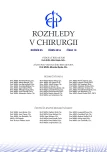Fluorescence angiography in the detection of anastomotic perfusion during rectal and sigmoid resection – preliminary report
Authors:
M. Škrovina 1,2; V. Benčurik 1; E. Holášková 1; J. Bartoš 1; K. Klos 1; M. Macháčková 1; P. Anděl 1
Authors‘ workplace:
Chirurgické oddělení, Nemocnice Nový Jičín, a. s., Centrum vysoce specializované onkologické péče pro dospělé Nový Jičín, primář: MUDr. M. Škrovina Ph. D.
1; I. chirurgická klinika, LF Univerzity Palackého a FN Olomouc, přednosta: prof. MUDr. Č. Neoral, CSc.
2
Published in:
Rozhl. Chir., 2016, roč. 95, č. 10, s. 354-358.
Category:
Original articles
Overview
Introduction:
The aim of the study was to evaluate the results of fluorescence angiography for assessing anastomotic perfusion after resection of the sigmoid colon and rectum since its introduction into clinical practice at the authors´ workplace and to evaluate the incidence of necessary resection line repositioning based on the quality of perfusion, and also to record any complications in anastomotic healing.
Method:
Retrospective unicentric analysis of prospectively collected data from patients with resection of the sigmoid colon and rectum with primary anastomosis. The patient set included 50 patients, 27 males and 23 females; the median age was 64.5 years (33–80). Forty-four patients were indicated for resection for cancer of the sigmoid colon or rectum, while 6 patients had a benign disease. Twenty-nine patients underwent total mesorectal excision with coloanal mechanical or hand-sewn anastomosis and 21 underwent resection of the sigmoid colon or upper rectum with mechanical anastomosis. Prior to the construction of the anastomosis, assessment of perfusion of the anastomotic segments by near infrared (NIR) indocyanine green (ICG) fluorescence angiography was performed in all patients. The quality of perfusion of the mesocolon and bowel wall and its impact on moving the resection line and complications of anastomotic healing 30 days postoperatively were all evaluated.
Results:
Assessment of perfusion using fluorescence angiography was technically successfully performed in all 50 patients. In 5 cases (10%) the resection line had to be moved for signs of poor perfusion of the bowel wall. Postoperatively, healing of the anastomosis was complicated in four patients (8%). Dehiscence was recorded in 3 patients (10.3%) with total mesorectal excision and in 1 patient (4.8%) after resection of the sigmoid colon and upper rectum.
Conclusion:
The presented results indicate that fluorescence angiography may lead to a decrease in the incidence of anastomotic dehiscence after colorectal resections by mapping in detail the perfusion of the anastomosed segments.
Key words:
fluorescence angiography – indocyanine green – anastomotic leak – colorectal resection
Sources
1. Kang CY, Halabi WJ, Chaudhry OO, et al. Risk factors for anastomotic leakage after anterior resection for rectal cancer. JAMA Surg 2013;148:65–71.
2. Matthiessen P, Hallböök O, Andersson M, et al. Risk factors for anastomotic leakage after anterior resection of the rectum. Colorectal Disease 2004;6:462–9.
3. Skrovina M, Straka M, Holaskova E, et al. Colon cancer – evaluation of complications and risks of planned resections. Rozhl Chir 2014;93:311–6.
4. Skrovina M, Soumarova R, Kycina R, et al. Anastomotic leakage after laparoscopic total mesorectal excision for low rectal cancer. Videosurgery and other miniinvasive techniques 2011;6:5–11.
5. Frye J, Bokey EL, Chapuis PH, et al. Anastomotic leakage after resection of colorectal cancer generates prodigious use of hospital resources. Colorectal Dis 2009;11:917–20.
6. Ashraf SQ, Burns EM, Jani A, et al. The economic impact of anastomotic leakage after anterior resection in English NHS hospitals: are we adequatly remunerating them? Colorectal Dis 2013;15:e190–8.
7. Vonlanthen R, Slankamenac K, Breitenstein S, et al. The impact of complications on costs of major surgical procedures: a cost analysis of 1200 patients. Ann Surg 2011;254:907–13.
8. Mirnezami A, Mirnezami R, Chandrakumaran K, et al. Increased local recurrence and reduced survival from colorectal cancer following anastomotic leak: systematic review and meta-analysis. Ann Surg 2011;253:890–9.
9. Daams F, Wu Z, Lahaye MJ, et al. Prediction and diagnosis of colorectal anastomosis leakage: a systematic review of literature. World J Gastrointest Surg 2014;6:14–26.
10. Nachiappan S, Askari A, Currie A, et al. Intraoperative assessment of colorectal anastomotic integrity: a systematic review. Surg Endosc 2014;28:2513–30.
11. James DRC, Ris F, Yeung TM, et al. Fluorescence angiography in laparoscopic low rectal and anorectal anastomoses with pinpoint perfusion imaging – a critical appraisal with specific focus on leak risk reduction. Colorectal Dis 2015;17(Suppl. 3):16–21.
12. Gröne J, Koch D, Kreis ME. Impact of intraoperative microperfusion assessment with Pinpoint Perfusion Imaging on surgical management of laparoscopic low rectal and anorectal anastomoses. Colorectal Dis 2015;17(Suppl. 3):22–8.
13. Kudszus S, Roesel C, Schachtrupp A, et al. Intraoperative laser fluorescence angiography in colorectal surgery: a noninvasive analysis to reduce the rate of anastomotic leakage. Langenbeck Arch Surg 2010;395:1025–30.
14. Sherwinter DA, Gallagher J, Donkar T. Intra-operative transanal near infrared imaging of colorectal anastomotic perfusion: a feasibility study. Colorectal Dis 2013;15:91–6.
15. Jafari MD, Lee KH, Halabi WJ, et al. The use of indocyanine green fluorescence to assess anastomotic perfusion during robotic assisted laparoscopic rectal surgery. Surg Endosc 2013;27:3003–8.
16. Ris F, Hompes R, Cunningham C, et al. Near-infrared (NIR) perfusion angiography in minimally invasive colorectal surgery. Surg Endosc 2014:28:2221–6.
17. Hellan M, Spinoglio G, Pigazzi A, et al. The influence of fluorescence imaging on the location of bowel transection during robotic left-sided colorectal surgery. Surg Endosc 2014;28:1695–702.
18. Watanabe J, Ota M, Suwa Y, et al. Evaluation of the intestinal blood flow near the rectosigmoid junction using the indocyanine green fluorescence method in a colorectal cancer surgery. Int J Colorectal Dis 2015;30:329–35.
19. Jafari MD, Wexner SD, Martz JE, et al. Perfusion assessment in laparoscopic left-sided/anterior resection (PILLAR II): a multi-institutional study. J Am Coll Surg 2015:220:82–92e1.
Labels
Surgery Orthopaedics Trauma surgeryArticle was published in
Perspectives in Surgery

2016 Issue 10
Most read in this issue
- Myxofibrosarcoma in the abdominal cavity
- Total pancreatectomy for pancreatic malignancy - from history to the present day
- Complete mesocolic excision during right hemicolectomy
- Liver metastases of malignant melanoma – utility of resection or radiofrequency ablation
